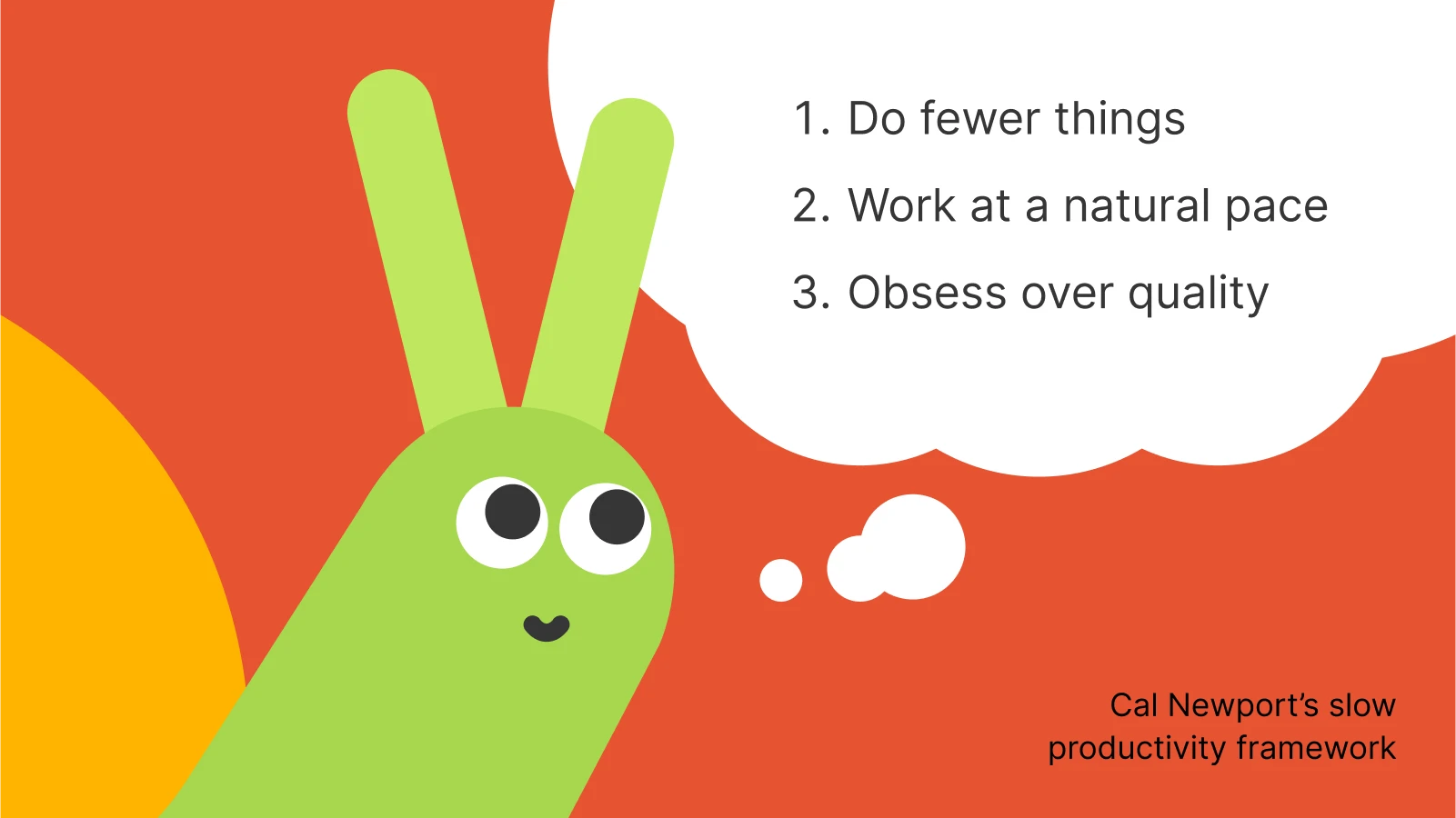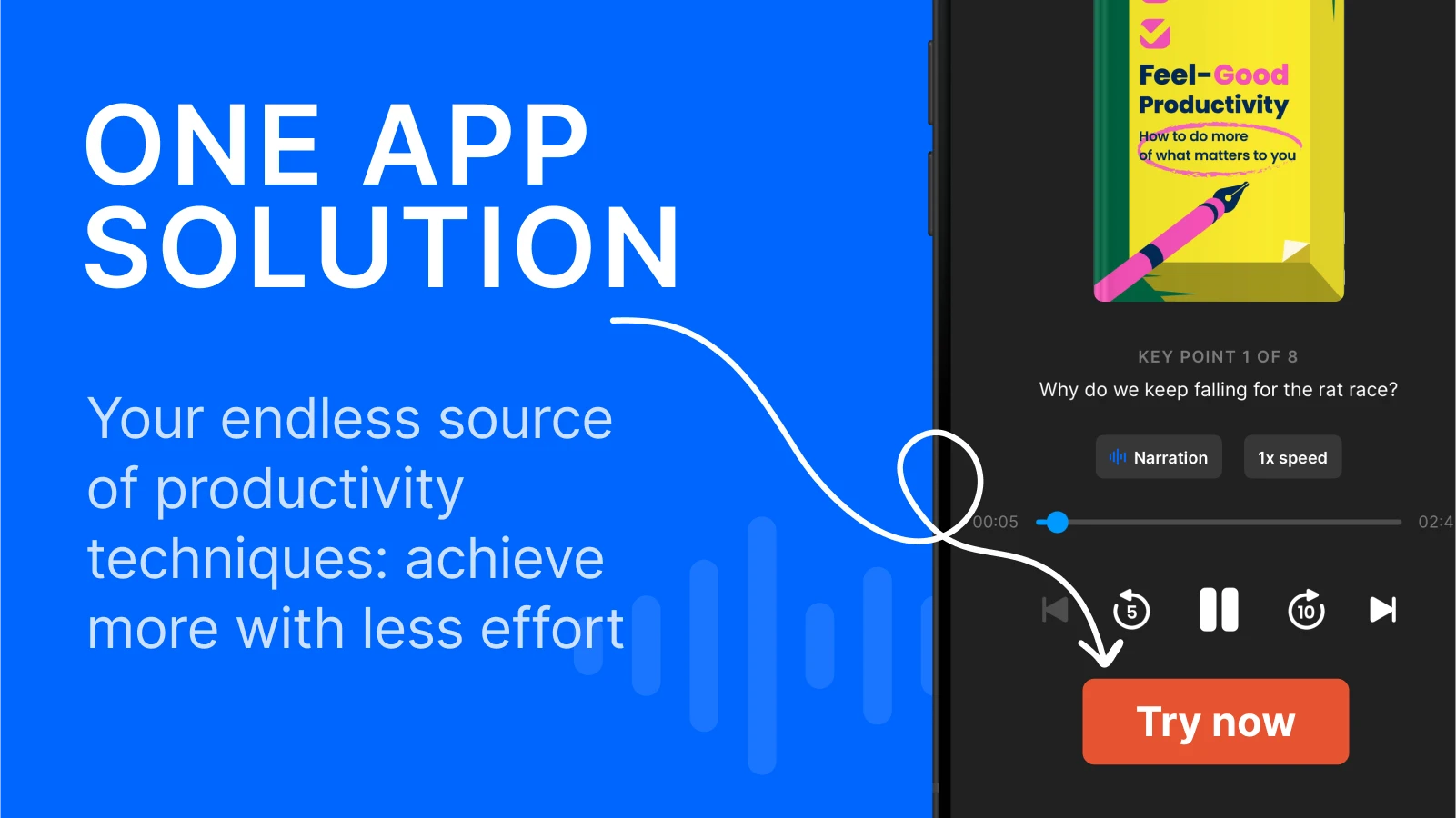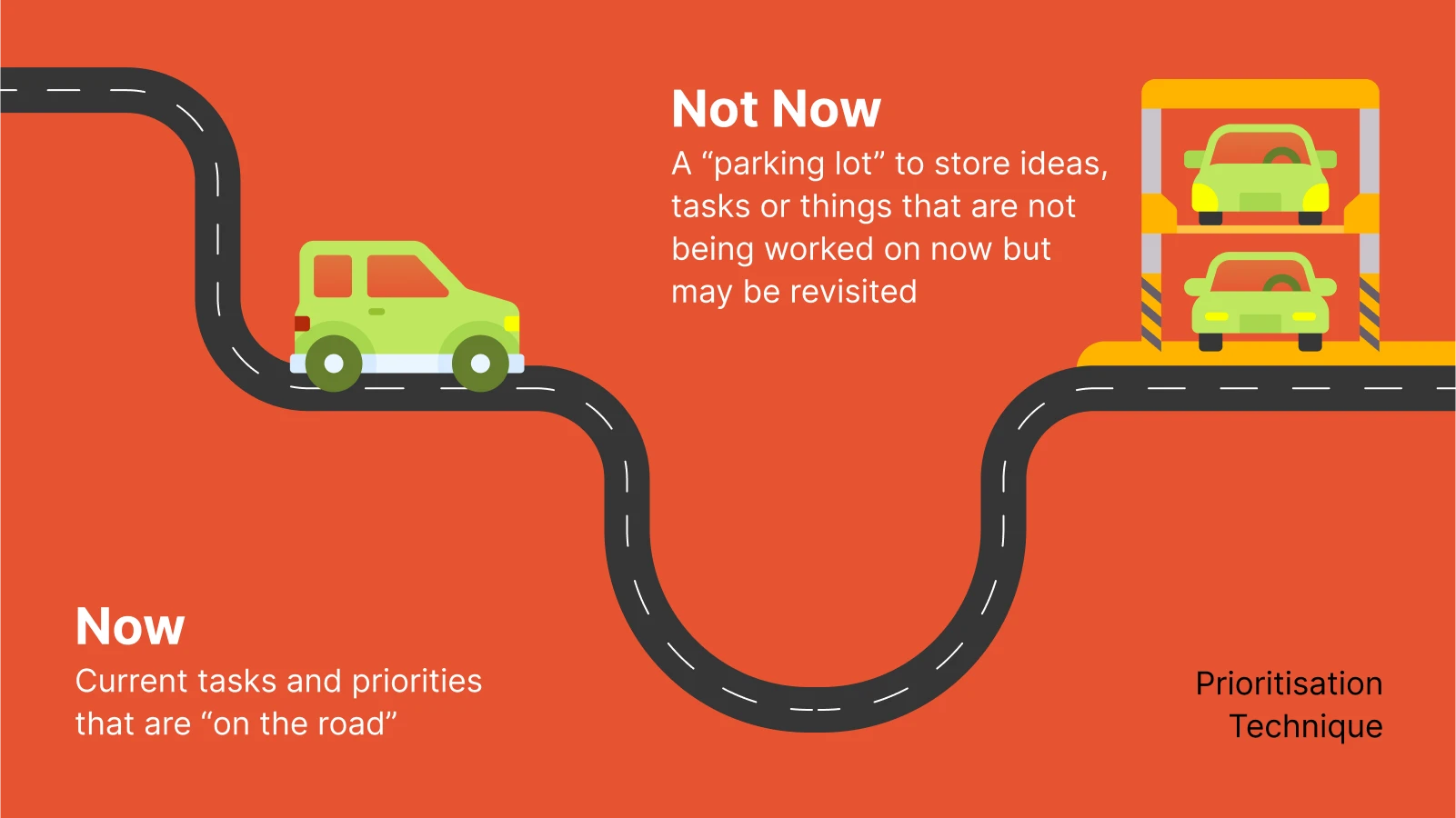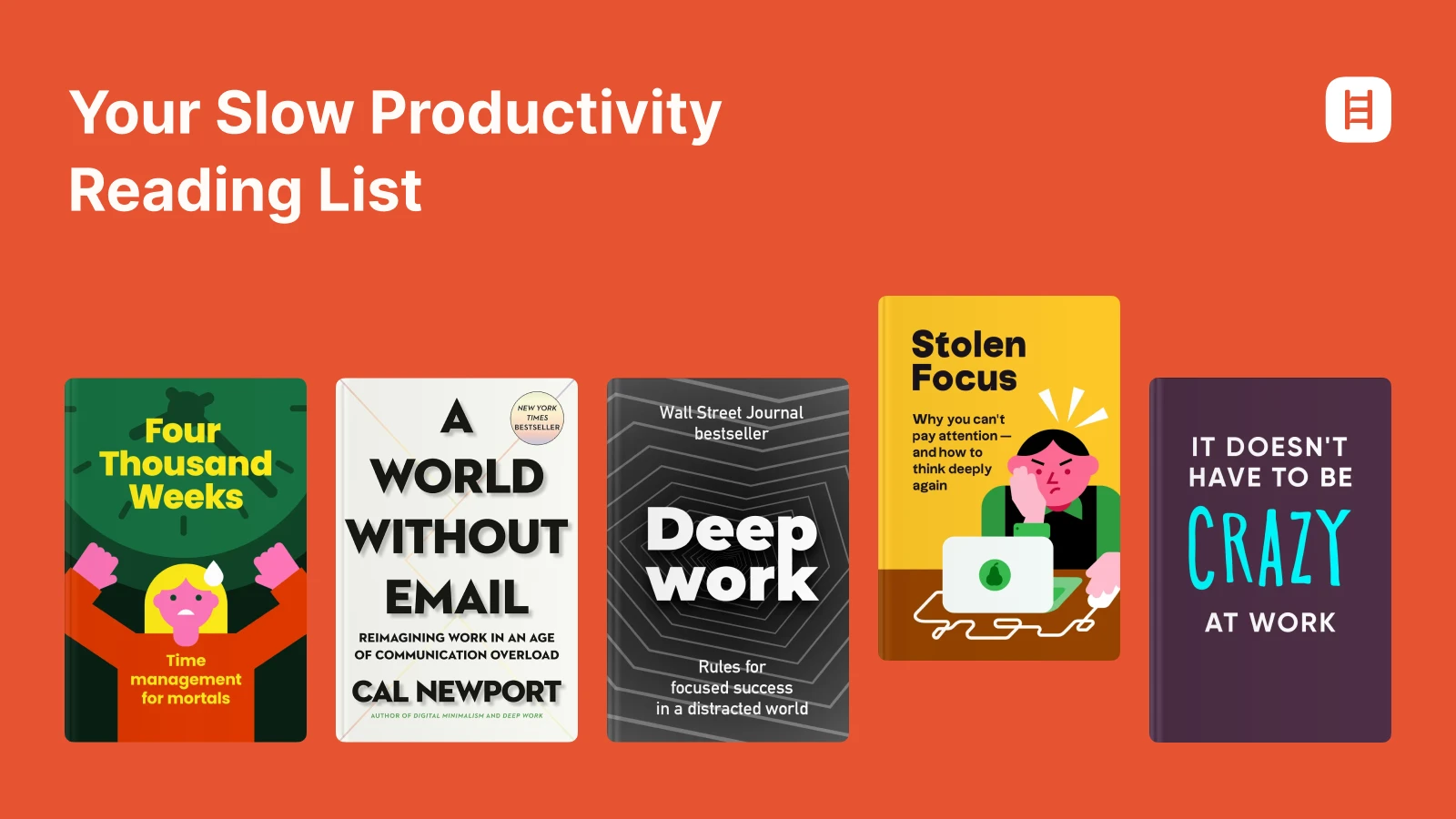Cal Newport, a computer science professor at Georgetown University and bestselling self-help author, coined the term "slow productivity" in his book 'Slow Productivity: The Lost Art of Accomplishment Without Burnout.' His approach challenges everything hustle culture taught us about getting our best work done.
This isn't about working less — it's about working smarter. For knowledge workers overwhelmed by pseudo-productivity (looking busy without meaningful results), slow productivity offers a framework to produce your best work without sacrificing your well-being.
Want to explore Newport's ideas in just 15 minutes? Get the key insights from 'Slow Productivity' and other productivity bestsellers on Headway — perfect for busy professionals who need actionable wisdom, fast.
Download Headway to explore more of Newport's bestsellers in just 15 minutes — because transforming how you work shouldn't take all day.
Key takeaways: How do you integrate slow productivity into your daily life?
The good news is that it’s pretty easy! Here’s how:
Start with three priorities: Limit yourself to three key tasks per day or week. Whether you're an entrepreneur managing your own work or a knowledge worker juggling multiple projects, if everything is urgent, nothing gets the focus it deserves.
Block deep work time: Protect two to four hour blocks in your calendar for uninterrupted focus on high-value work. Silence Slack notifications, close social media tabs, and treat these blocks like unmovable meetings.
Use the Now/Not Now method: Sort tasks into two categories — those that need your attention now, and those that can wait. This simple filter prevents overwhelm without resorting to quiet quitting when you feel burned out.
Work with your energy, not against it: Notice when you're most focused and schedule demanding knowledge work during those windows. No productivity hacks can override the need for genuine rest.
Track where your time actually goes: Run a time audit for one week to identify what's draining your hours — whether it's excessive social media scrolling, back-to-back Slack conversations, or low-value economic activity that doesn't move you toward your goals.
Ask yourself deep questions before saying yes: Before accepting new commitments, pause and reflect: Does this align with my values? Does it support my current goals? Do I have the capacity to do this work well right now?
When and how slow productivity emerged
The phrase "slow productivity" was introduced by Cal Newport, a computer science professor and bestselling author of 'So Good They Can't Ignore You: Why Skills Trump Passion in the Quest for Work You Love.'
He expanded on the idea in his book 'Slow Productivity: The Lost Art of Accomplishment Without Burnout' in 2024.
His ethos emerged as a response to modern hustle culture and what he calls pseudo-productivity — the appearance of being busy without meaningful results. His framework is based on three principles:
Do fewer things
Work at a natural pace
Obsess over quality
While Cal Newport gave "slow productivity" its name in 2024, similar ideas have been around far longer. David Allen's book, 'Getting Things Done' (2001), laid out a system for what he called "stress-free productivity." He emphasized the removal of mental clutter to create space for focused work.
More recently, the concept of "peaceful productivity" has appeared in coaching and blogs. In 2023, Ali Abdaal's 'Feel-Good Productivity' suggested that fulfillment and positive emotion, rather than willpower and discipline, are necessary for sustained achievement.
Slow productivity also shares DNA with the slow living movement. This philosophy originated as a response to the fast-food industry in the 1980s and has since expanded into various aspects of life. Slow living promotes intentionality, presence, and prioritising quality over speed. Slow productivity is the work-life application of slow living, making work more meaningful and sustainable.
Why slow productivity works
Slow productivity delivers tangible benefits that directly impact performance, well-being, and overall job satisfaction. By rethinking how we approach work and letting go of the "always on" mentality, we can create space for more meaningful work. That's how we can build better relationships with our careers. Here's why slow productivity works:
Reduced burnout
The emphasis on working at a natural pace and accepting ebb and flow in productivity allows for vital recovery, making it much less likely that chronic stress or exhaustion will enter the picture.
Better quality output
Fewer priorities mean more time to think, refine, and deliver exceptional results.
Deeper focus
By encouraging us to do fewer things at once, slow productivity eliminates distractions and multitasking, enabling deeper concentration on the most meaningful tasks. This helps boost cognitive clarity, reduces errors and helps us make meaningful progress on complex, high-value projects.
Work satisfaction
By shifting away from relentless busyness and constant hustle, we experience less overwhelm and greater satisfaction, as progress aligns with personal and professional values rather than arbitrary metrics of busyness.
The three core principles of slow productivity
At the heart of slow productivity are three simple principles. They act as a framework for working in a way that allows you to prioritise what really matters.
1. Do fewer things
Limit the number of projects or major goals you take on at any one time so your energy and attention aren't fragmented. Ask yourself: If I could only accomplish one thing this week, what would have the biggest impact?
2. Work at a natural pace
Pace your work to fit your energy, the complexity of the task, and realistic timeframes. Remember that our creativity and problem-solving abilities peak at certain times of the day or week, and we need periods of lighter effort or rest to allow the brain to recover.
3. Obsess Over Quality
When you're not racing against the clock, you have the space to think critically, refine your work, and create outputs you're genuinely proud of. Then, you can prioritise high-quality, thoughtful work over volume.
How to implement slow productivity principles
I always encourage my clients to experiment with various time management strategies, as you may find that one works better than others. Here are a couple of standard time management techniques that can help with slow productivity.
The Pomodoro technique
The Pomodoro technique is widely recognised. It involves breaking work into focused 25-minute intervals separated by short breaks, most often five minutes. For those practising slow productivity, this can be a gentle way to ease into challenging tasks without feeling overwhelmed.
Rather than pushing through in one long, exhausting stretch, Pomodoro encourages you to work with your attention span, take mindful pauses, and return to the task refreshed. The emphasis isn't on racing against the timer, but on creating a sustainable rhythm of focus and rest.
Time blocking
If you haven't yet tried time blocking, then this is your sign to give it a shot! It's a simple yet highly impactful time management technique that involves breaking your day into distinct blocks and assigning specific tasks or activities to each one.
By allocating time in advance, you can create a structured day and ensure that your most important tasks receive the attention they deserve. Time blocking can help reduce distractions, and it forces you to assess your priorities and ensure that the important but not urgent tasks get done.
I also time block my personal hours, and by doing so, I have been able to intentionally create a healthier work-life balance. A lot of people don't plan their personal time or their evenings after work. However, if you’re intentional with your time, you’ll know where it goes. Time blocking can help you achieve this.
Seasonal pacing
Rather than operating at the same intensity throughout the year, seasonal pacing involves intentionally building periods of high focus and output, followed by lighter seasons for rest, reflection, and strategic thinking.
This could align with literal seasons (e.g., creative sprints in spring and autumn, and slower planning phases in winter and summer) or with your business cycles (e.g., launching in Q2 and Q4, then regrouping in Q1 and Q3). This ebb and flow prevents burnout and ensures you're not running at full capacity indefinitely.
Seasonal pacing also makes it easier to align work with personal life rhythms, such as intentionally reducing workloads during school holidays or leaning into quieter months for learning and development. It's about zooming out, viewing your year as a whole, and creating a balanced rhythm that supports both productivity and well-being.
No meeting days
One of the simplest ways to create the mental space slow productivity requires is to introduce regular no-meeting days. By blocking out a full day in your calendar with zero scheduled calls, you reclaim large chunks of uninterrupted time, which is perfect for deep, high-value work. Without the stop-start nature of back-to-back meetings, your brain can stay in focus mode for hours at a time, making it easier to work at a natural pace and produce quality results.
It can also encourage more intentional communication, prompting teams to replace some meetings with written updates or utilize asynchronous tools. You may find it hard to block a day per week for no meetings, but even one or two days a month can be impactful; I have a day blocked each month for 'admin' and another for 'thinking'. You could also pair no-meeting days with seasonal pacing, dedicating no-meeting days during certain months or project phases when you need maximum concentration to push important work over the finish line.
Prioritisation
In a world full of opportunities, requests, and "urgent" tasks, saying yes by default is one of the fastest paths to overwhelm. Slow productivity invites us to pause before committing, to ask whether each task or project truly deserves our attention right now. It's about making space for the work that genuinely matters.
Before you agree to take something on, ask yourself three questions:
Does this align with my values? Will it help me build the kind of business or life I want?
Does it support my current goals? Will it move me closer to what I've already decided is important this month or this season?
Do I have the capacity right now? Will saying yes support my energy and focus, or will it spread me too thin?
If the answer to any of these is no, it might belong in the "Not Now" category. This is an idea you revisit later, rather than adding it to today's workload.
The Now/Not Now method is a beautifully straightforward way to manage competing priorities. You look at everything on your plate and ask:
Does this need my time and energy now? Or not now?
That's it. Two buckets. No complex matrix, no colour-coded urgency scales. Just clarity and ease.
Originally popularised by agile and product management expert Mike Cohn, this method aligns with how our brains naturally make decisions. We’re wired to focus on what feels immediate and concrete, and this technique leverages that tendency.
Many teams will refer to a 'parking lot' as a place to store ideas, tasks, or things that are not being worked on now but may be revisited (our 'not now' bucket). This then allows us to keep our focus on current tasks and priorities that are 'on the road' (our 'now' bucket).
"Not now" doesn't mean "never." It just means you get to protect your focus.
You give yourself permission to defer, to breathe, to finish what matters most first.
Tools & Resources
There are various tools that can support slow productivity.
Task management is an important element of slow productivity. We want to be able to track fewer, higher-value tasks but also retain ideas for future projects. I personally use Asana, an online project management tool. There, I have active projects that I'm working on now, as well as projects that are ideas to implement at a future date, categorized as 'not now'. But having them in the tool means I won't forget them.
Being able to protect our focus and attention is at the heart of slow productivity. Even with the best intentions, our concentration is constantly under siege from pings, pop-ups, and endless notifications, along with the temptation of "just checking" one more thing. Every distraction, no matter how small, pulls us out of deep work and forces our brain to reorient, wasting valuable energy. Focus apps such as Screen Zen can help reduce digital noise by blocking distracting sites and limiting screen time.
A Time Audit can also be a useful exercise, and an app such as Toggl can facilitate this. A Time Audit will give you a clear picture of how you’re truly spending your time, not how you think you spend it. It often reveals hidden patterns, distractions, or time-consuming tasks that go unnoticed. You can identify tasks that are taking up your time, but not moving you in the direction of your goals, whether that's professional or personal.
Through the Time Audit, you will likely understand your natural energy cycles too; it can highlight productive windows of time and periods of lower focus. This can be very helpful as you can then think about blocking time for deep work at the best time for you.
In addition to thinking about how you’re using your time currently, I also like to encourage my clients to think about their ideal week. With clarity around their values and future vision, they can begin to determine the boundaries that they need to put in place to achieve their goals and the daily habits to cultivate.
For a deeper dive, it's worthwhile exploring these latest books:
'Four Thousand Weeks' by Oliver Burkeman: A reality check on time management that encourages you to accept your limitations and focus on what truly matters, rather than trying to do everything.
'A World Without Email: Reimagining Work in an Age of Communication Overload' by Cal Newport: This New York Times bestseller tackles how constant messaging destroys knowledge work and offers practical alternatives to inbox tyranny.
'Deep Work' by Cal Newport: Newport's groundbreaking book on achieving focused success in a distracted world. Learn why eliminating shallow work and embracing deep concentration produces your best results.
'Stolen Focus' by Johann Hari: An eye-opening investigation into why we've lost our ability to concentrate and what we can do to reclaim our attention from technology and distraction.
'It Doesn't Have to Be Crazy at Work' by Jason Fried and David Heinemeier Hansson: A manifesto for calm companies that reject hustle culture. This new book challenges the assumption that growth requires chaos and exhaustion.
Want the key insights from these books in 15 minutes each? Check out Headway, where you can absorb the core principles of digital minimalism and sustainable productivity without spending weeks reading.
Not sure where to start? Try starting at the end. Many readers check out book reviews on the website first and then dive into the title.
Real-life examples of slow productivity
When we think of significant scientific breakthroughs, we often picture flashes of genius. Well, reality is usually slower.
For instance, Isaac Newton's achievements were the product of years of deep, uninterrupted work. His most famous discoveries in mathematics, physics, and astronomy weren't the result of endless to-do lists.
Instead, they were results of long periods of focused thinking, experimentation, and refinement. Newton worked on his theories over decades, allowing ideas to develop slowly and thoroughly.
This is slow productivity in its purest form: creating lasting impact by working at a pace that prioritises depth and quality over speed. I've experienced this in my own career as well.
During my three years completing a PhD, I spent the entire time immersed in one very niche idea. Even after all that focused work, I felt like I had only scratched the surface. That experience taught me that meaningful progress comes from not rushing through many things, but committing to one.
You may have heard about the trials of a four-day workweek. They have shown that reducing working hours doesn't necessarily mean sacrificing output. On the contrary, companies report higher productivity and significantly improved employee well-being. These results mirror slow productivity principles: doing fewer things, but doing them better, and aligning work patterns with human energy rather than the clock.
Common myths about slow productivity
Slow productivity often faces resistance because people misunderstand what it means. Now let's reveal what slow productivity really looks like in practice:
| Myth | Reality |
|---|---|
Slowing down means doing less forever | Slow productivity is about doing less at once so you can give each priority the attention it deserves. It's about timing projects intentionally and producing work of lasting value — not lowering your standards or output over time. |
It's only for people with light workloads | The opposite is true. When demands are high, slow productivity forces clarity on what's really essential. By stripping away busywork and spreading projects across realistic timelines, you protect your energy and deliver consistently without burning out. |
It's unrealistic in a fast-paced environment | The approach isn't about ignoring urgency. It's about controlling what you can. Even in high-pressure settings, you can protect blocks of uninterrupted time, streamline meetings, and filter tasks so your energy goes to work that actually moves the needle. |
It will make you less ambitious | Choosing a slower, more intentional approach doesn't mean lowering your ambitions; it means taking a more deliberate route. Burnout, constant context switching, and endless firefighting erode your ability to achieve big goals. Slow productivity ensures you have the focus, creativity, and stamina to pursue ambitious projects without sacrificing your well-being. |
Begin your slow productivity journey with Headway
Try this one-week experiment:
Choose no more than three key tasks for the week.
Use time blocking to plan deep work in your calendar. Assign your priorities to dedicated time slots in your week. Treat these blocks as non-negotiable appointments with yourself.
End your workday when your planned tasks are done, not when you're exhausted.
When you slow down, you'll often find you get more meaningful work done, and you'll feel better doing it.
Want to make time your ally, not your enemy? Start exploring Headway's slow productivity audiobook and text summaries and discover how to achieve more by doing less.
FAQs about slow productivity
What is slow productivity?
Slow productivity is a work philosophy that promotes doing fewer things at a natural pace while maintaining high quality and avoiding burnout. Coined by Cal Newport in 2024, it was also explored by The New Yorker, which highlighted the shift toward sustainable productivity — valuing focus, depth, and quality over constant activity or visible busyness.
Is slow productivity the same as working slowly?
Not at all. Slow productivity isn't about dragging your feet or reducing ambition; it's about pacing your work sustainably so you can maintain focus, energy, and creativity over the long term. It's the difference between sprinting until you collapse and running a steady, strategic marathon. Slow and steady wins the race.
Can I use slow productivity if I have a demanding job?
Yes. In fact, it's especially valuable when your workload is heavy. By identifying what's essential, protecting deep work time, and eliminating low-value busywork, you can meet important deadlines without constantly operating in firefighting mode.
How many tasks should I focus on each day?
Aim for no more than three key priorities each day. This simple rule helps you stay intentional and prevents burnout by focusing your energy where it truly matters. Instead of scattering attention across countless to-dos, slow productivity encourages you to move meaningfully through fewer tasks — achieving progress that actually supports your long-term goals and well-being.
How do I balance slow productivity with urgent deadlines?
Build buffer time into projects and set realistic timelines. For unavoidable urgent work, focus on protecting at least part of your day for meaningful, high-impact tasks or deep work. That way, short-term urgency doesn't completely derail your long-term goals.
Will my output drop if I switch to slow productivity?
Initially, it may feel like you're doing less because you're focusing on fewer things. However, most people find that their meaningful output actually increases because they're completing more critical work to a higher standard, rather than scattering their effort across too many low-value tasks.











